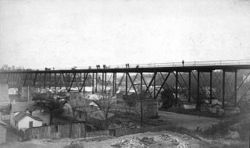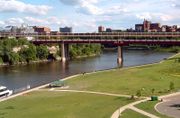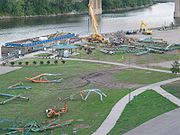
Bohemian Flats
Encyclopedia

Minneapolis, Minnesota
Minneapolis , nicknamed "City of Lakes" and the "Mill City," is the county seat of Hennepin County, the largest city in the U.S. state of Minnesota, and the 48th largest in the United States...
. The area was the low lying river terrace on west bank of the Mississippi River
Mississippi River
The Mississippi River is the largest river system in North America. Flowing entirely in the United States, this river rises in western Minnesota and meanders slowly southwards for to the Mississippi River Delta at the Gulf of Mexico. With its many tributaries, the Mississippi's watershed drains...
, a short distance southeast of St. Anthony Falls. About the time Minneapolis was incorporated (1867), immigrants seeking employment in the city or at the mills at St. Anthony settled there. In 1884, the first Washington Avenue Bridge
Washington Avenue Bridge (Minneapolis)
The Washington Avenue Bridge carries County Road 122 across the Mississippi River in Minneapolis, Minnesota and connects the East Bank and West Bank portions of the University of Minnesota's main campus...
was constructed over the area, linking central Minneapolis with the campus
Campus
A campus is traditionally the land on which a college or university and related institutional buildings are situated. Usually a campus includes libraries, lecture halls, residence halls and park-like settings...
of the University of Minnesota
University of Minnesota
The University of Minnesota, Twin Cities is a public research university located in Minneapolis and St. Paul, Minnesota, United States. It is the oldest and largest part of the University of Minnesota system and has the fourth-largest main campus student body in the United States, with 52,557...
, on the east bank of the river.
Culture
The area known as "Bohemian Flats" was so named because a high percentage of the population came from eastern Europe; the majority of the families occupying the area were SlovaksSlovaks
The Slovaks, Slovak people, or Slovakians are a West Slavic people that primarily inhabit Slovakia and speak the Slovak language, which is closely related to the Czech language.Most Slovaks today live within the borders of the independent Slovakia...
, Swedes, Czechs (Bohemians), and Germans
Germans
The Germans are a Germanic ethnic group native to Central Europe. The English term Germans has referred to the German-speaking population of the Holy Roman Empire since the Late Middle Ages....
. The census of 1900 gives a good idea of the demographics of the area.
{| class="wikitable"
|-
! Origin
! North of Bridge
! South of Bridge
|-
| Slovaks
| 613
| 22
|-
| Swedes
| 123
| 85
|-
| Czech
| 90
| 105
|-
| Irish
| 41
| 8
|-
| Norwegian
| 27
| 2
|-
| German
| 5
| 23
|}
"Obviously there was oceans and whole continents lying between this place and the area above, even though only a bridge separates them"
Because it was a melting pot of nationalities, Bohemian Flats was known by other names as well. In early times, it was known as “The Danish Flats”, due to Danish population. Later it would be called Little Bohemia, Connemara Patch, Little Ireland
Ireland
Ireland is an island to the northwest of continental Europe. It is the third-largest island in Europe and the twentieth-largest island on Earth...
, Little Lithuania
Lithuania
Lithuania , officially the Republic of Lithuania is a country in Northern Europe, the biggest of the three Baltic states. It is situated along the southeastern shore of the Baltic Sea, whereby to the west lie Sweden and Denmark...
, Cabbage Patch, and in the spring time, it was known as Little Venice. With all of the different nationalities, many "mini" communities were formed.
Employment in the Flats community was very important. Everyone worked or went to school. Young children and the unemployable elderly collected wood which floated down river from the mills. Women worked as seamstresses, domestics, sorting cucumbers, and collecting mushrooms (a favorite of the Flats). Men worked a variety of jobs in lumber yards, copper shops, saw mills, breweries, railroads & streetcars. Wages at some of the large mills worked out to be $1.50 to $2.00 a day.
The wives, who stayed home, raised children and cooked, put lots of pride in their food. A variety of foods were popular on the Flats. Mushrooms gathered from the cliffs, Bohemian cheese, goat butter, river fruit, cabbage, sauerkraut, grapes, and over 35 varieties of potatoes could be found.
In a unique tradition, on the first Monday of Easter, the boys would spray the girls with water. Girls supposedly got "luck" from it, and then treated the guys to dinner. The next day, the roles were reversed.
The homes built on the Flats were no more than shanties. They had no foundation and the structures were often faulty . Many people did not care to make a permanent residence because the Mississippi River constantly caused problems. The Mississippi was known to flood in the spring, which was a problem for the dwellings, because the Flats were not much higher than the normal river level. Each spring the water would rise and flood the area, many times taking the poorly constructed houses with the receding waters. The residents of the flooding houses would go to higher ground. Many people would "bunk" their belongings and poultry in hopes of not losing everything to the water. Each year dead animals would litter the streets after flood waters had receded.
Structure and changes
The Flats comprised three major areas: the upper flats, and the north and south lower flats. The houses on the upper flats were popular and in high demand because they were not affected by the flood waters in the spring. The upper and lower flats were separated by a cliff. Houses on the upper flats rented for about $15-20 a year, compared to the lower flats which ranged from $.50-2.00. Reaching the lower flats required a descent of 79 stairs. The lower flats was an area of dense population with homesites very small and condensed. The upper flats had much more room by comparison. The lower flats were divided into southern and northern sections by the Washington Avenue Bridge. The bridge separated people economically and ethnically. Early immigrants and higher-paid residents lived south of the bridge. After World War IWorld War I
World War I , which was predominantly called the World War or the Great War from its occurrence until 1939, and the First World War or World War I thereafter, was a major war centred in Europe that began on 28 July 1914 and lasted until 11 November 1918...
, an expansion was made. It was called the "Washington Avenue Addition". It was bounded by the Washington Avenue Bridge, South 2nd Street, and to the north Minneapolis Brewing & Malting Association. It encompassed Wood Street and bits of Mill Street and Cooper Street. The Flats remained the same until the 1930s when the city of Minneapolis wanted to expand its barge terminal facilities. Eminent domain
Eminent domain
Eminent domain , compulsory purchase , resumption/compulsory acquisition , or expropriation is an action of the state to seize a citizen's private property, expropriate property, or seize a citizen's rights in property with due monetary compensation, but without the owner's consent...
was used by the city to force evacuations of the area. A coal barge terminal and storage yard occupied the lower flats after the residents were removed and houses cleared out. In the 1940s a large brick building was built for housing single men who worked at the mills. This building was soon inhabited by families. The community began to use this building as a community center.
Bohemian Flats currently

University of Minnesota
The University of Minnesota, Twin Cities is a public research university located in Minneapolis and St. Paul, Minnesota, United States. It is the oldest and largest part of the University of Minnesota system and has the fourth-largest main campus student body in the United States, with 52,557...
West Bank, several Lipa Slovak Dancers gather by the Mississippi River for demonstrations on Bohemian Day (August 20). Their music and dancing fill the air on the grounds of the previous Bohemain Flats below the Washington Avenue
Washington Avenue (Minneapolis)
Washington Avenue is a major thoroughfare in Minneapolis, Minnesota. Starting north of Lowry Avenue, the street runs straight south, with Interstate 94 running alongside it until just south of West Broadway, when the freeway turns to the west...
Bridge, which once housed immigrants from the Bohemian region of Eastern Europe.

Slovaks
The Slovaks, Slovak people, or Slovakians are a West Slavic people that primarily inhabit Slovakia and speak the Slovak language, which is closely related to the Czech language.Most Slovaks today live within the borders of the independent Slovakia...
, Germans
Germans
The Germans are a Germanic ethnic group native to Central Europe. The English term Germans has referred to the German-speaking population of the Holy Roman Empire since the Late Middle Ages....
, Scandinavians
Scandinavians
Scandinavians are a group of Germanic peoples, inhabiting Scandinavia and to a lesser extent countries associated with Scandinavia, and speaking Scandinavian languages. The group includes Danes, Norwegians and Swedes, and additionally the descendants of Scandinavian settlers such as the Icelandic...
, Irish
Irish people
The Irish people are an ethnic group who originate in Ireland, an island in northwestern Europe. Ireland has been populated for around 9,000 years , with the Irish people's earliest ancestors recorded having legends of being descended from groups such as the Nemedians, Fomorians, Fir Bolg, Tuatha...
, and Italians
Italian people
The Italian people are an ethnic group that share a common Italian culture, ancestry and speak the Italian language as a mother tongue. Within Italy, Italians are defined by citizenship, regardless of ancestry or country of residence , and are distinguished from people...
. The Lipa Slovak Dancers dress in traditional costumes all made by a woman from Slovakia. The Lipa Slovak group is named after the national tree of Slovakia, the linden tree in North America. They perform several times per year at events such as Czech festivals and the Festival of Nations.
The organizers want to remember the Bohemian Flats and its residents and also want to talk about the American immigrant experience in general.
See also
- Washington Avenue BridgeWashington Avenue Bridge (Minneapolis)The Washington Avenue Bridge carries County Road 122 across the Mississippi River in Minneapolis, Minnesota and connects the East Bank and West Bank portions of the University of Minnesota's main campus...
- St. Anthony Falls
External links
- The Bohemian Flats - A website about this neighborhood and its history

